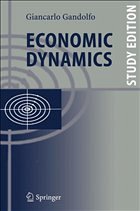Nicht lieferbar

Economic Dynamics
Study Edition
Versandkostenfrei!
Nicht lieferbar
Weitere Ausgaben:
Treating the mathematical methods used in the economic dynamics, this book shows how they are utilised to build and analyse dynamical models. Accordingly, the focus is on the methods, and every new mathematical technique introduced is followed by its application to select economic models. The mathematical methods covered range from elementary linear difference and differential equations and simultaneous systems to the qualitative analysis of non-linear dynamical systems. Stability considerations are stressed throughout, including many advanced topics. Synergetics and catastrophy theory are als...
Treating the mathematical methods used in the economic dynamics, this book shows how they are utilised to build and analyse dynamical models. Accordingly, the focus is on the methods, and every new mathematical technique introduced is followed by its application to select economic models. The mathematical methods covered range from elementary linear difference and differential equations and simultaneous systems to the qualitative analysis of non-linear dynamical systems. Stability considerations are stressed throughout, including many advanced topics. Synergetics and catastrophy theory are also dealt with. The reader is guided through a step-by-step analysis of each topic, be it a mathematical method or an economic model. The Study Edition also provides the reader with solutions to the numerous exercises.
Table of contents:
Linear Difference Equations: Difference Equations: General Principles: First-order Difference Equations; First-order Difference Equations in Economic Models; Second-order Difference Equations; Second-order Difference Equations in Economic Models; Higher-order Difference Equations; Higher-order Difference Equations in Economic Models; Simultaneous Systems of Difference Equations; Simultaneous Difference Systems in Economic Models.- Linear Differential Equations: Differential Equations: General Principles; First-Order Differential Equations; First-order Differential Equations in Economic Models; Second-order Differential Equations; Second-order Differential Equations in Economic Models; Higher-order Differential Equations; Higher-order Differential Equations in Economic Models; Simultaneous Systems of Differential Equations; Differential Equation Systems in Economic Models.- Advanced Topics: Comparative Statics and the Correspondence Principle; Stability of Equilibrium; Saddle Points and Economic Dynamics; Liapunov's Second Method; Introduction to Nonlinear Dynamics; Bifurcation Theory; Complex Dynamics; Mixed Differential-Difference Equations.
Table of contents:
Linear Difference Equations: Difference Equations: General Principles: First-order Difference Equations; First-order Difference Equations in Economic Models; Second-order Difference Equations; Second-order Difference Equations in Economic Models; Higher-order Difference Equations; Higher-order Difference Equations in Economic Models; Simultaneous Systems of Difference Equations; Simultaneous Difference Systems in Economic Models.- Linear Differential Equations: Differential Equations: General Principles; First-Order Differential Equations; First-order Differential Equations in Economic Models; Second-order Differential Equations; Second-order Differential Equations in Economic Models; Higher-order Differential Equations; Higher-order Differential Equations in Economic Models; Simultaneous Systems of Differential Equations; Differential Equation Systems in Economic Models.- Advanced Topics: Comparative Statics and the Correspondence Principle; Stability of Equilibrium; Saddle Points and Economic Dynamics; Liapunov's Second Method; Introduction to Nonlinear Dynamics; Bifurcation Theory; Complex Dynamics; Mixed Differential-Difference Equations.



